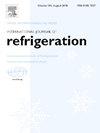Energy utilization of CO2 thermal management system for electric vehicles in cold climate: Assessment of different heat source modes
IF 3.5
2区 工程技术
Q1 ENGINEERING, MECHANICAL
International Journal of Refrigeration-revue Internationale Du Froid
Pub Date : 2025-03-21
DOI:10.1016/j.ijrefrig.2025.03.025
引用次数: 0
Abstract
To further improve the heating energy efficiency at low temperatures, this study analyzes the feasibility of a CO2 electric vehicle (EV) utilizing different heat source (air source, waste heat-only, and dual-source) modes under low-temperature conditions. Initially, the difference in heating energy efficiency between air source and waste heat-only modes was compared at different supply air temperatures of -10°C. Concurrently, the dual heat source mode was evaluated at -20°C, emphasizing the impact of the electronic expansion valve 3 (EEV3) opening on heating performance at different constant coolant temperatures. This study presents an evaluation method for heating performance, and the temperature rise characteristics of a real vehicle in air source mode at -20°C are validated through environmental chamber experiments. The results indicate that the inner gas cooler outlet refrigerant temperature strongly correlates with the maximum heating capacity. When the supply air temperature is set to 50°C, the compressor power consumption in the waste heat-only mode decreases by 12.9 % compared with the air source mode, and the COP increases by 13.5 %. As the supply air temperature rises, the efficiency improvements of the COP gradually decrease. Compared with the air source mode, the heating capacity of the dual heat source mode increased by 6.4 %-19.2 %, the COP improved by 4.5 %-5.7 %, and the driving range improved by 9.4 %-15.6 %. This study demonstrates that the thermal management system can meet the temperature rise characteristics, and the maximum outlet air temperature of the air source mode reaches 56.83°C at -20°C.
寒冷气候下电动汽车CO2热管理系统的能量利用:不同热源模式的评价
为了进一步提高低温下的加热能效,本研究分析了低温条件下不同热源(空气源、纯余热和双源)模式的CO2电动汽车的可行性。首先,在-10°C的不同送风温度下,比较了空气源和仅余热模式之间的加热能效差异。同时,在-20℃条件下对双热源模式进行了评估,强调了电子膨胀阀3 (EEV3)开度对不同恒温冷却剂温度下加热性能的影响。本研究提出了一种加热性能评价方法,并通过环境室实验验证了实际车辆在-20℃空气源模式下的温升特性。结果表明,气体冷却器出口冷媒温度与最大制热能力密切相关。当送风温度设置为50℃时,与空气源模式相比,仅余热模式下压缩机功耗降低12.9%,COP提高13.5%。随着送风温度的升高,COP的效率提高逐渐降低。与空气源模式相比,双热源模式的发热量提高了6.4% ~ 19.2%,COP提高了4.5% ~ 5.7%,续驶里程提高了9.4% ~ 15.6%。本研究表明,该热管理系统能够满足温升特性,在-20℃时,气源模式的最大出风口温度达到56.83℃。
本文章由计算机程序翻译,如有差异,请以英文原文为准。
求助全文
约1分钟内获得全文
求助全文
来源期刊
CiteScore
7.30
自引率
12.80%
发文量
363
审稿时长
3.7 months
期刊介绍:
The International Journal of Refrigeration is published for the International Institute of Refrigeration (IIR) by Elsevier. It is essential reading for all those wishing to keep abreast of research and industrial news in refrigeration, air conditioning and associated fields. This is particularly important in these times of rapid introduction of alternative refrigerants and the emergence of new technology. The journal has published special issues on alternative refrigerants and novel topics in the field of boiling, condensation, heat pumps, food refrigeration, carbon dioxide, ammonia, hydrocarbons, magnetic refrigeration at room temperature, sorptive cooling, phase change materials and slurries, ejector technology, compressors, and solar cooling.
As well as original research papers the International Journal of Refrigeration also includes review articles, papers presented at IIR conferences, short reports and letters describing preliminary results and experimental details, and letters to the Editor on recent areas of discussion and controversy. Other features include forthcoming events, conference reports and book reviews.
Papers are published in either English or French with the IIR news section in both languages.

 求助内容:
求助内容: 应助结果提醒方式:
应助结果提醒方式:


